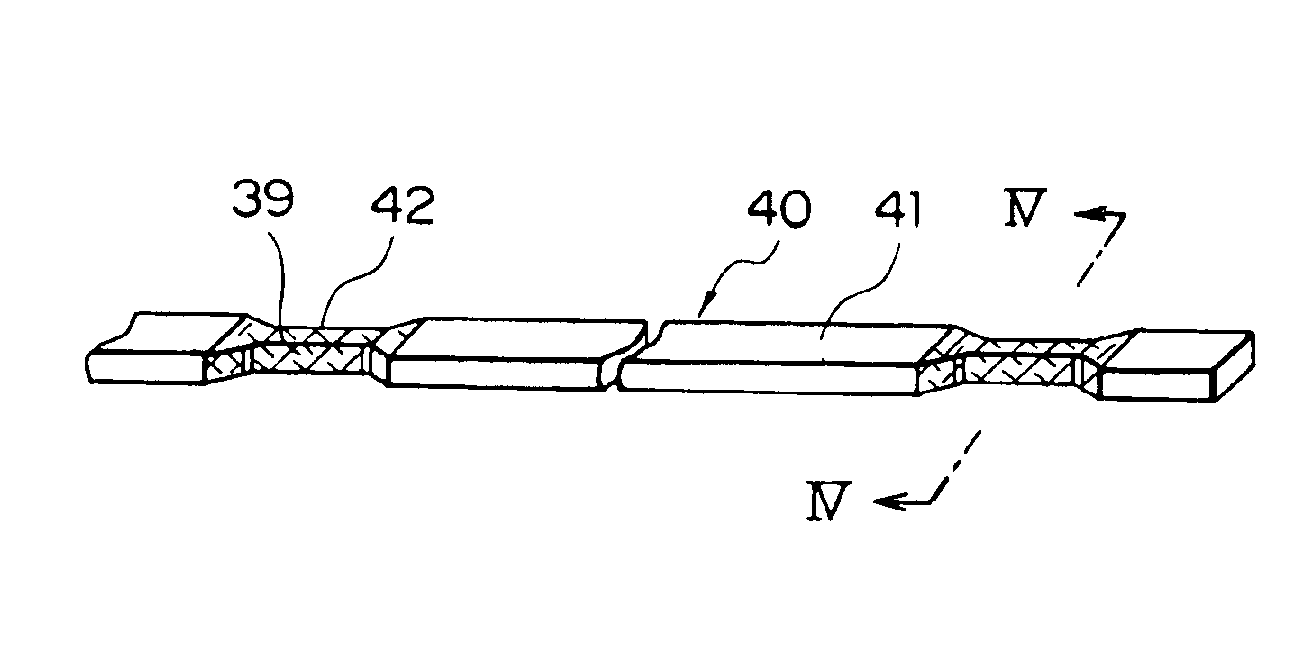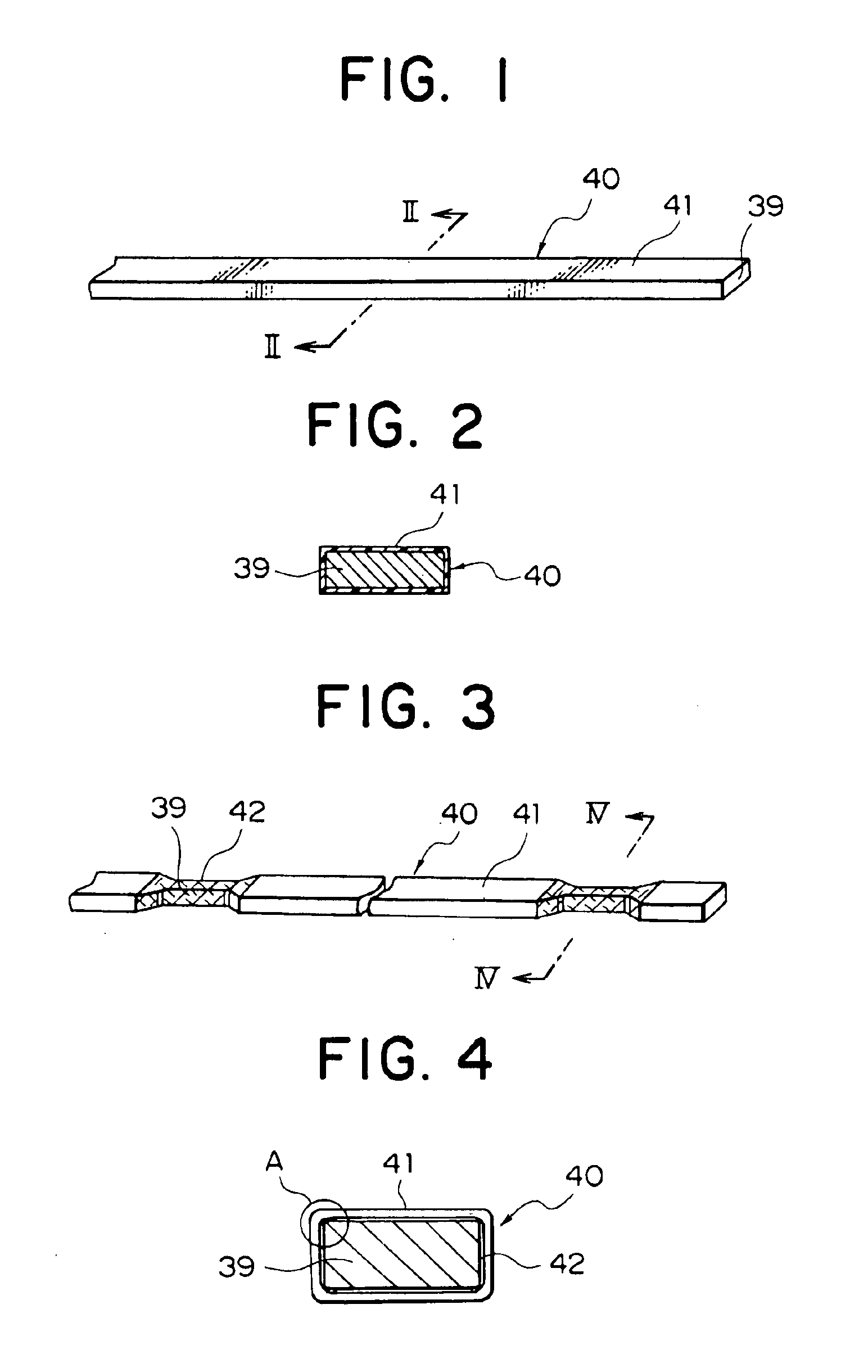Method of manufacturing a stator for an alternator with reduced conductor portions
a technology of conductors and stators, which is applied in the manufacture of stators/rotors, magnets, and magnetic bodies, etc., can solve the problems of difficult coil inserting, insulation defects, insulating paper, etc., and achieve the effect of improving productivity and reliability
- Summary
- Abstract
- Description
- Claims
- Application Information
AI Technical Summary
Benefits of technology
Problems solved by technology
Method used
Image
Examples
embodiment 1
FIG. 1 is a perspective showing wire material used in a stator coil of a stator for an alternator according to Embodiment 1 of the present invention, FIG. 2 is a cross section taken along line II—II in FIG. 1, FIG. 3 is a perspective showing reduced outer portions formed in the wire material in a method for manufacturing the stator for an alternator according to Embodiment 1 of the present invention, FIG. 4 is a cross section taken along line IV—IV in FIG. 3, FIG. 5 is an enlargement of portion A in FIG. 4, FIG. 6 is a perspective showing coil members formed by cutting the wire material in the method for manufacturing the stator for an alternator according to Embodiment 1 of the present invention, FIG. 7 is a perspective showing a coil segment formed by applying a bending process to a coil member in the method for manufacturing the stator for an alternator according to Embodiment 1 of the present invention, FIGS. 8 and 9 are an end elevation and a side elevation, respectively, expla...
embodiment 2
FIG. 15 is a perspective showing width-reduced portions formed in a wire material in a method for manufacturing a stator for an alternator according to Embodiment 2 of the present invention, FIG. 16 is a cross section taken along line XVI—XVI in FIG. 15, and FIG. 17 is a perspective showing width-reduced portions of wire material with insulation coating removed in a method for manufacturing a stator for an alternator according to Embodiment 2 of the present invention.
Embodiment 2 is constructed similarly to Embodiment 1 above except for the fact that width-reduced portions 43A are formed in the wire material 40 using a press-cutting method instead of a machining process.
As shown in FIGS. 15 and 16, in Embodiment 2, the width-reduced portions 43A are formed by cutting the electrical conductor 39 on both sides of the wire material 40 together with the insulation coating 41 in the width direction over a predetermined range in the longitudinal direction at predetermined distances using ...
embodiment 3
In Embodiments 1 and 2 above, the insulation coating 41 was removed by applying a machining process to the upper and lower surfaces of the width-reduced portions formed at predetermined distances along the wire material 40, but in Embodiment 3, the insulation coating 41 is burned by directing a flame onto the width-reduced portions of the wire material 40, and then carbides formed by burning the insulation coating 41 are removed by brushing.
According to Embodiment 3, because the insulation coating 41 is burned by a flame, the insulation coating can be removed simply and reliably without contact. Thus, unremoved insulation coating is eliminated from the weld portions, preventing in advance poor weldability as a result of such remnants.
PUM
| Property | Measurement | Unit |
|---|---|---|
| Thickness | aaaaa | aaaaa |
| Electrical conductivity | aaaaa | aaaaa |
| Shape | aaaaa | aaaaa |
Abstract
Description
Claims
Application Information
 Login to View More
Login to View More - R&D
- Intellectual Property
- Life Sciences
- Materials
- Tech Scout
- Unparalleled Data Quality
- Higher Quality Content
- 60% Fewer Hallucinations
Browse by: Latest US Patents, China's latest patents, Technical Efficacy Thesaurus, Application Domain, Technology Topic, Popular Technical Reports.
© 2025 PatSnap. All rights reserved.Legal|Privacy policy|Modern Slavery Act Transparency Statement|Sitemap|About US| Contact US: help@patsnap.com



